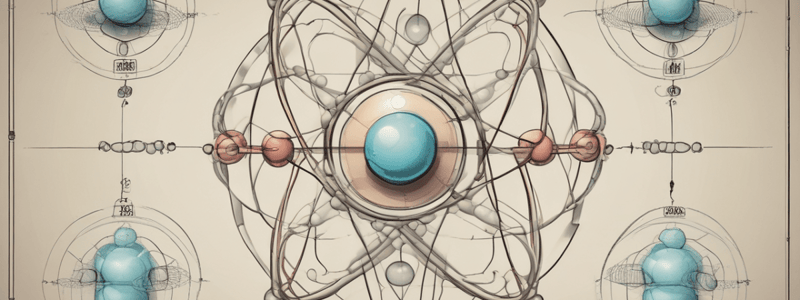Podcast
Questions and Answers
John ______________ proposed Dalton's Atomic Model in 1803.
John ______________ proposed Dalton's Atomic Model in 1803.
Dalton
Thomson's Plum Pudding Model states that atoms are composed of a positively charged ______________ with negatively charged electrons embedded within.
Thomson's Plum Pudding Model states that atoms are composed of a positively charged ______________ with negatively charged electrons embedded within.
sphere
Rutherford's Nuclear Model proposes that atoms have a small, dense, positively charged ______________ at the center.
Rutherford's Nuclear Model proposes that atoms have a small, dense, positively charged ______________ at the center.
nucleus
According to Bohr's Quantum Mechanical Model, electrons occupy specific ______________ levels or shells around the nucleus.
According to Bohr's Quantum Mechanical Model, electrons occupy specific ______________ levels or shells around the nucleus.
The Modern Atomic Model combines the principles of ______________ mechanics and relativity.
The Modern Atomic Model combines the principles of ______________ mechanics and relativity.
In the Modern Atomic Model, electrons occupy ______________ distributions or orbitals around the nucleus.
In the Modern Atomic Model, electrons occupy ______________ distributions or orbitals around the nucleus.
According to Dalton's Atomic Model, atoms of the same element are ______________.
According to Dalton's Atomic Model, atoms of the same element are ______________.
Thomson's Plum Pudding Model did not explain the structure of the ______________ or the arrangement of electrons.
Thomson's Plum Pudding Model did not explain the structure of the ______________ or the arrangement of electrons.
Flashcards are hidden until you start studying
Study Notes
Atomic Models
Dalton's Atomic Model (1803)
- Proposed by John Dalton
- Key features:
- Atoms are indivisible and cannot be created or destroyed
- Atoms of the same element are identical
- Atoms of different elements have different masses
- Compounds are formed when atoms of different elements combine in whole number ratios
- Limitations:
- Did not explain the structure of atoms
- Did not account for the existence of subatomic particles
Thomson's Plum Pudding Model (1897)
- Proposed by J.J. Thomson
- Key features:
- Atoms are composed of a positively charged sphere with negatively charged electrons embedded within
- Electrons are like plums within a pudding of positive charge
- Limitations:
- Did not explain the nucleus or the arrangement of electrons
- Did not account for the existence of neutrons
Rutherford's Nuclear Model (1911)
- Proposed by Ernest Rutherford
- Key features:
- Atoms have a small, dense, positively charged nucleus at the center
- Negatively charged electrons orbit the nucleus at a distance
- Most of the atom's mass is concentrated in the nucleus
- Limitations:
- Did not explain the arrangement of electrons or the structure of the nucleus
Bohr's Quantum Mechanical Model (1913)
- Proposed by Niels Bohr
- Key features:
- Electrons occupy specific energy levels or shells around the nucleus
- Electrons jump from one energy level to another by emitting or absorbing energy
- Each energy level can hold a specific number of electrons
- Limitations:
- Did not explain the behavior of electrons in multi-electron atoms
- Did not account for the existence of electron spin
Modern Atomic Model
- Combines the principles of quantum mechanics and relativity
- Key features:
- Atoms have a nucleus composed of protons and neutrons
- Electrons occupy probability distributions or orbitals around the nucleus
- Electrons have spin and exhibit wave-like behavior
- Atoms can exist in different energy states and can be excited or ionized
Atomic Models
Dalton's Atomic Model
- John Dalton proposed the model in 1803
- Atoms are indivisible, cannot be created or destroyed, and are indestructible
- Atoms of the same element are identical in terms of their properties
- Atoms of different elements have different masses and properties
- Compounds are formed when atoms of different elements combine in whole number ratios
Thomson's Plum Pudding Model
- J.J. Thomson proposed the model in 1897
- Atoms consist of a positively charged sphere with negatively charged electrons embedded within
- Electrons are like plums within a pudding of positive charge, with the positive charge spread evenly throughout
Rutherford's Nuclear Model
- Ernest Rutherford proposed the model in 1911
- Atoms have a small, dense, positively charged nucleus at the center
- Negatively charged electrons orbit the nucleus at a distance, with most of the atom's mass concentrated in the nucleus
- Electrons occupy specific energy levels or shells around the nucleus
Bohr's Quantum Mechanical Model
- Niels Bohr proposed the model in 1913
- Electrons occupy specific energy levels or shells around the nucleus
- Electrons jump from one energy level to another by emitting or absorbing energy
- Each energy level can hold a specific number of electrons, with a maximum capacity
Modern Atomic Model
- Combines principles of quantum mechanics and relativity
- Atoms have a nucleus composed of protons and neutrons
- Electrons occupy probability distributions or orbitals around the nucleus
- Electrons have spin and exhibit wave-like behavior
- Atoms can exist in different energy states and can be excited or ionized
Studying That Suits You
Use AI to generate personalized quizzes and flashcards to suit your learning preferences.




